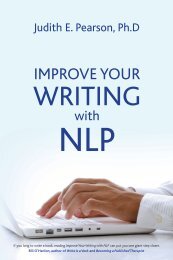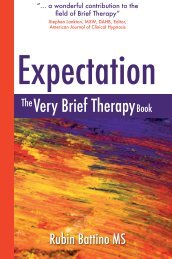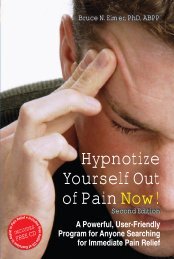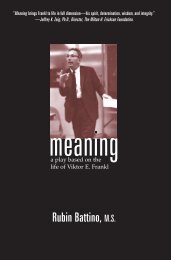14 | A2 PSYCHOLOGY: THE STUDENT’S TEXTBOOKCORRELATIONSadvantagesweaknesses●●Naturally occurring variables can be measured <strong>and</strong> ●●Cannot imply cause or effect, <strong>and</strong> variables area relationship between the two identified. This may almost impossible to control. Even if the analysislead to future research.indicates that there is no relationship we cannot becertain of that. It could be that something else thatwe have not measured or considered is happeningthat the analysis is not sensitive to.A correlation coefficient of near to +1 means thatthere is a strong positive correlation between thetwo variables. As one goes up, so does the other.For instance, the longer it rains, the wetter you willget if st<strong>and</strong>ing outside. This may not be a perfectpositive correlation because it may be that at somepoint your clothing becomes completely saturated<strong>and</strong>, however much more rain falls on you, youcannot possibly get any wetter.Correlations are represented on scattergraphs (alsoknown as scattergrams). On page 13 we have threescatterplots identifying the relationships describedabove.Do not think that correlation means cause. It doesnot. Just because two variables are positively correlateddoes not mean that one causes the other.For instance, it is extremely likely that were you tocollect the data you would find that the numberof cars on the roads of the United Kingdom hasrisen steadily over the last 10 years. You would alsoprobably find that the number of people takingholidays abroad has gone up. The two variables(car sales <strong>and</strong> holidays abroad) are likely to bepositively correlated. We cannot conclude, however,that increased car sales have caused peopleto take more holidays. There may be a third factorthat we have not considered, such as ‘amount ofdisposable income’ that is related to both of thesevariables, but that we have not measured.Watch Out! Dem<strong>and</strong>characteristics <strong>and</strong>investigator effectsThere are a few things to keep in mind whendesigning research. Dem<strong>and</strong> characteristics, investigatoreffects, reliability <strong>and</strong> validity can all causeproblems for a researcher.Dem<strong>and</strong> characteristics – Something in aresearch design may change a participant’sbehaviour. If this happens then your data will notgive you a true picture of what’s going on in yourstudy. For instance, participants who know somethingabout the procedure may alter their behaviourto provide the researcher with the responsesthey think the researcher would like. Researchersoften design ‘single blind’ procedures to eliminate,or at least attempt to eliminate, dem<strong>and</strong> characteristics.These are procedures where participantsare kept naive about the aims of the research. Itis the job of the researcher to plan the study so asto minimise dem<strong>and</strong> characteristics. Eliminatingthem is often very difficult indeed.Investigator effects – These are a little likedem<strong>and</strong> characteristics, but you should try not tomix them up! Research suffers with investigatoreffects when the researchers themselves influencethe behaviour of the participant in some way. Theymay not do so on purpose, but they may give awaytheir opinion in some way which may encourageInvestigator EffectsDem<strong>and</strong> CharacteristicsExtract from A2 Psychology: The Student’s Textbook © <strong>Nigel</strong> <strong>Holt</strong> <strong>and</strong> <strong>Rob</strong> <strong>Lewis</strong> ISBN: 9781845901004 www.crownhouse.co.uk
DESIGNING PSYCHOLOGICAL INVESTIGATIONS | 15the participant to respond differently for the restof the session. Researchers may introduce a doubleblindprocedure to eliminate these effects. Here theresearcher <strong>and</strong> the participant do not know of theaims of the research, <strong>and</strong> so neither can influencethe results by inadvertently responding in certainways.Dem<strong>and</strong> characteristics, investigatoreffects, reliability <strong>and</strong> validity areextremely useful things to considerwhen you comment on the researchyou read about. Have these in mind whenthinking critically about the methodology used. Youcan often pick up valuable marks by making one ortwo effective comments based on these issues whenevaluating research.Sampling strategiesFinding participants is something that all researchershave to do. A group of participants is referredto as a sample. A researcher cannot test everyonein the world, <strong>and</strong> would not want to. The idea isto select a sample of people who can be describedas representative of the wider population. If thesample really is representative then we can say thatwe are able to generalise our results to the largergroup. There are three sampling strategies, eachwith strengths <strong>and</strong> weaknesses that have implicationsfor your research.R<strong>and</strong>om samplingThis is where all of the people in a populationhave the same chance of being selected.Generalisability <strong>and</strong> biasThe vulnerability of r<strong>and</strong>om samples to drop-outsmeans that the sample is easily biased, as theresearcher must either go with a reduced sampleor choose another r<strong>and</strong>om participant, who by thevery fact that they were not originally ‘r<strong>and</strong>omlychosen’ is not very r<strong>and</strong>om at all.Similarly, it’s very difficult to carry out a trulyr<strong>and</strong>om sample if you have a very large populationas it is unlikely that you will have a complete list ofnames from which to choose. This means that noteveryone is equally likely to be chosen <strong>and</strong> so thesample is not truly r<strong>and</strong>om, but rather, it is biasedtowards ‘people on your list’.You must ask yourself how the names got onto thelist in the first place. For instance, researchers mayhave used a telephone directory. If this was thecase then the sample would be limited to thosethat own a phone <strong>and</strong> have their details listed.Some researchers may use the electoral register. Ifthey do this then the sample is limited to thosepeople who are 18 or over who have indicated thatthey wish to be able to vote in elections; <strong>and</strong> furtherlimited because people whose names are onthe full register are allowed to opt out of inclusionon the shorter version, to which researchers <strong>and</strong>others have access. In both these cases the sampleis not generalisable to those in the population whodo not meet these criteria.Opportunity samplingThis is where anyone h<strong>and</strong>y is asked to participate.The most typical opportunity sample in psychologyis one where researchers simply ask peoplein their department or college to take part. Forinstance, a researcher may put up a notice askingfor people to help out in their research, or maysimply approach people in the cafe <strong>and</strong> ask themfor help.Generalisability <strong>and</strong> biasTypically, researchers choose people to take partfrom their own social group. They may, if notdeliberately, choose people they would like to takepart, whom they find attractive in some way. Orthey may choose people who have taken part inprevious research, <strong>and</strong> whom they trust. It mayeven be that the researchers only ask those whothey think are least likely to reject their requests.Since choices are made, <strong>and</strong> the samples aredrawn, from such a narrow population, the extentto which the findings can be generalised to thewider population is very limited.Similarly, those who take part may have their ownmotives for doing so. At university, students maytake part in their lecturer’s research because theymay feel that helping out will gain them moremarks. This may leave the research open to bias inthat the participant may attempt to provide datathat will please the researcher in some way.The other problem with an opportunity sample isthat only those who want to take part do so. Thismeans that you may find that the sample has alarge proportion of ‘helpful’ or ‘interested’ participants,who may provide biased data. Obviously,this reduces the generalisability of the findings, asthe sample is not reflective of the wider, generalpopulation. This means it has low ecological validity– we’ll cover this more in a moment.Volunteer samplingThis is also known as ‘self-selected’ sampling. Herepeople who want to take part do so. For example,Extract from A2 Psychology: The Student’s Textbook © <strong>Nigel</strong> <strong>Holt</strong> <strong>and</strong> <strong>Rob</strong> <strong>Lewis</strong> ISBN: 9781845901004 www.crownhouse.co.uk

















